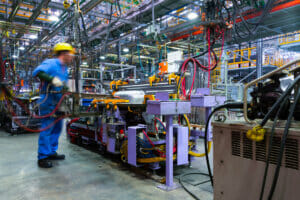 The COVID-19 pandemic has had a huge impact globally, across all industries, and while many of us hope that the worst of the pandemic crisis is over, many industries may never return to “normal.”
The COVID-19 pandemic has had a huge impact globally, across all industries, and while many of us hope that the worst of the pandemic crisis is over, many industries may never return to “normal.”
Companies with a high customer touch rate where employees are constantly meeting people outside of the organization such as at restaurants, airlines, or banks will take longer to return to “normal.” Others, such as manufacturers, are able to return more rapidly than you’d expect because of their motivation to innovate and rethink the way they work.
So, how have manufacturers responded to the crisis to safeguard their business?
Remote Work and Accelerating Automation
Traditionally, manufacturing employees have always worked at a central location, be it a factory or plant. The COVID-19 pandemic turned that on its head. Because of the enforced lockdown closures, the crisis created an opportunity for manufacturers to innovate. Post pandemic, we are likely to see record low numbers of manufacturing employees physically returning to the place of work.
Digital transformation will play a key role in the future of manufacturing. This was already happening pre-COVID-19 and is now being accelerated. Modern factories have benefited from the rise in automation which has resulted in fewer employees being physically present during the manufacturing process than 50 to 60 years ago. Moreover, a significant percentage of the manufacturing processes are computer driven. After COVID-19, automation will accelerate alongside vendor risk management software investment resulting in even less physical interaction along the assembly line.
Rethinking the Manufacturing Floor
Manufacturers are finding ways to separate workers by spacing them farther apart, removing them from the production floor, or putting protective dividers between them. Given that efficiencies are based upon workers being within a certain proximity of each other, spacing may require additional automation or redesign of production lines to maintain operational resilience. In some cases, where workers are monitoring robotic systems, they may be removed from the floor and placed in a control center with appropriate distancing. However, one thing is for sure: additional automation is required to achieve the level of efficiency realized pre-COVID-19.
Embracing Change and Innovation
Many factories changed the products they made as a direct response to the pandemic. There were examples of gin and beer companies suddenly producing hand sanitizer, clothing companies producing protective equipment for the healthcare industry, and shoe manufacturers producing face masks. Due to advancements in digital design and 3D printing technology, businesses were able to quickly respond to the change in market demand. As a large portion of the manufacturing process is digitized and automated, production staff were also able to quickly adapt.
The economy is subject to change, and a new crisis can impact the market again. Those manufacturers who can adapt, exploit the change, and recognize the abilities of their workforce are those that will be the most successful.






